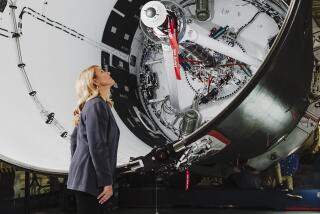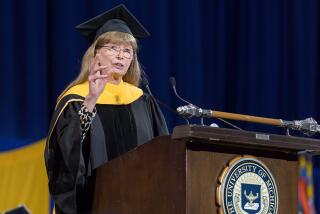The Southern California Woman: ON THE JOB : MAKING IT : The Personal Stories of Six Women Who Have Found Success in Individual Ways : MILLIE KRONFLY : Space Shuttle Engineer
WHEN MILLIE KRONFLY awoke in Houston on the morning of Jan. 28, 1986, she turned on her television, saw the icicles on the ground at Cape Canaveral, Fla., and knew the space shuttle Challenger couldn’t possibly be blasting off that day. So, instead of going to the Mission Evaluation Room at NASA, Kronfly, then manager for Rockwell’s Space Transportation Systems Division, went to work at Rockwell’s offices near the Johnson Space Center.
A short while later, there was a knock on the office door where Kronfly was working. “Excuse me for interrupting,” she remembers a secretary saying, “but the shuttle just blew up.”
Kronfly was on the next plane and back at Rockwell’s Downey space transportation systems division within hours, trying to help NASA assess just what had gone wrong with the Challenger. Although the problem didn’t involve the orbiter, which Rockwell is primarily responsible for, the accident still caused “a lot of introspection” on everyone’s part, she says. “It was horrible,” recalls Kronfly, 38, now Rockwell’s director of flight systems design and performance. “The real shock of it didn’t really hit me until we successfully launched the next one.”
“The first eight minutes” of the Sept. 29, 1988, launch of Discovery, she says, “was absolute pins and needles. I was so exhausted just trying to get through the first 73 seconds, which is where our last mission ended. Flying again was a great uplifting event,” she says in an interview at Rockwell’s space transportation division. “It was a picture-perfect mission.”
It’s not surprising the accident affected her so. The space shuttle is designed, developed and built, as well as prepared for flight, at Rockwell, in close concert with NASA. And Kronfly is an engineering department head responsible for overseeing the shuttle in specific areas, including designing and analyzing systems for guidance, navigation and flight control. Pretty impressive for a woman who once thought she’d become a math teacher.
Although women in engineering are no longer a rarity--at Rockwell, for example, they make up about 20% of the engineering population, about average throughout the industry--that was certainly not true when Kronfly was hired 15 years ago. Then, there were only two other women in the entire engineering division. “I looked at those two as having been the trailblazers,” she says.
Kronfly is modest about her own achievements, but she moved quickly into the ranks of upper management, becoming the youngest supervisor, manager and director the company had ever promoted along the way She’s now one of 17 directors at the aerospace firm.
Kronfly’s fascination with space started early: She remembers drawing pictures of rocket engines and rocket ships as a young girl. “I was fascinated with engines for some reason,” recalls Kronfly, who has a refreshingly open way of talking. “But I really didn’t have any inkling I’d end up in this field.”
She grew up on a chicken ranch in Hemet in the ‘60s. Inspired by a favorite teacher in high school, she decided to become a math teacher. Along with her three sisters and a brother, Kronfly says she was encouraged by their parents to get an education and become independent.
But after graduating from Whittier College with a degree in math education in 1972, she discovered that there was a glut of math teachers on the market and began looking at other options. A friend suggested that she try Rockwell, which had just landed the NASA space shuttle contract. At 23, Kronfly was hired to work in a software group at Rockwell, a job requiring her math skills; she was one of a handful of females in the department at the time. Being one of a few women in a sea of men was a situation Kronfly knew well.
“When you took math as much as I did, you got used to being the only girl in the class,” she recalls with a laugh. “Actually, it was a blast! It wasn’t inhibiting and I never had a problem.” What she did face at Rockwell, Kronfly remembers, is a lot of teasing about her age, which she says she took as a “normal reaction” from the many veteran Rockwell employees she first worked with.
In the engineering field, Kronfly says, respect from peers is established with one’s technical credibility. “They’ll patronize you until you gain their respect,” she says. In her early days at the firm, as she was “growing up” at Rockwell, Kronfly frequently turned to her three sisters for support. After she’d been at the company for some time, it became apparent that she’d have to take some engineering courses to “keep up with the guys,” as she puts it.
“I was programming requirements for the on-board control systems (of the shuttle), and it was generally advised I get some engineering control theory classes,” she remembers. “(Rockwell) has expectations that you get yourself up to speed.” After a series of these classes at Cal State Long Beach, as well as engineering management-training classes at West Coast College (all paid for by Rockwell), Kronfly began rising through the corporate ranks. She attributes her rapid ascension to several factors, including interesting assignments that gave her high-level visibility in the corporation.
These projects also got Kronfly the attention of several mentors, from whom she learned important lessons: to speak out, challenge people technically on the suitability of their designs, become accountable for her own work and, especially, to “ask the right questions.” This has been especially vital as Kronfly has been repeatedly promoted and has had to delegate authority, she points out. For example, as the only woman director in Rockwell’s engineering division, Kronfly supervises 270 employees, 60 of whom are certified to do flight support for the shuttle during all the pre-launch activities. Two of the 12 managers and 30 of the others she supervises are women.
Not surprisingly, Kronfly’s work schedule leaves her with little free time. Up at 4:15 a.m., she puts a Michael Jackson tape in her Walkman and attacks her stationary bike for an hour before car-pooling to work with husband, Bud, a 30-year Rockwell employee, from their Brea home. At her desk by 7 a.m., Kronfly says she typically works through lunch and finishes her day at the office by about 5:30. She spends evenings at home three out of five nights, going through a pile of documents requiring her signature or catching up on other business. And at least one weekend a month, she’s at the office working.
By choice, the couple has no children.
Kronfly says her husband’s emotional support has been invaluable through her career. “He lets me do my thing--which mostly revolves around work,” she says, adding half-jokingly: “I’m kind of one-dimensional.”
Kronfly has two goals: to learn to play the piano and to make it into the next level of upper management, which would mean being promoted to chief engineer on a project, or becoming a vice president of engineering. “It’s a fun field to be in, really,” she says before rushing into a work-related seminar. “I really am highly enthusiastic about my job and about the (space shuttle) program I’m in.”
More to Read
Sign up for Essential California
The most important California stories and recommendations in your inbox every morning.
You may occasionally receive promotional content from the Los Angeles Times.










